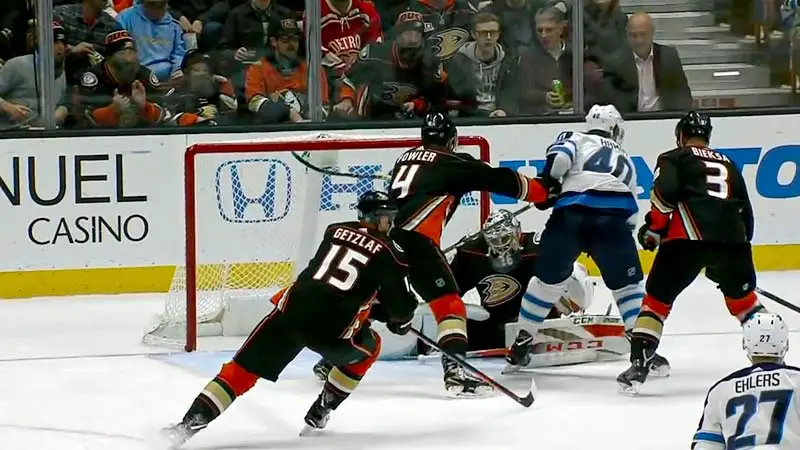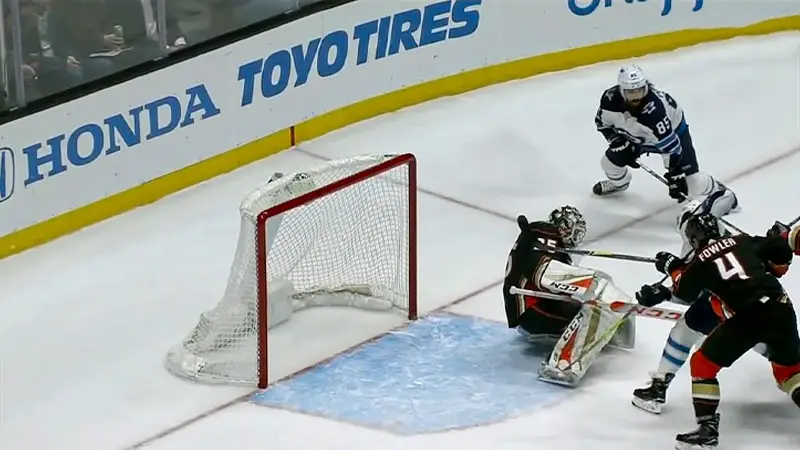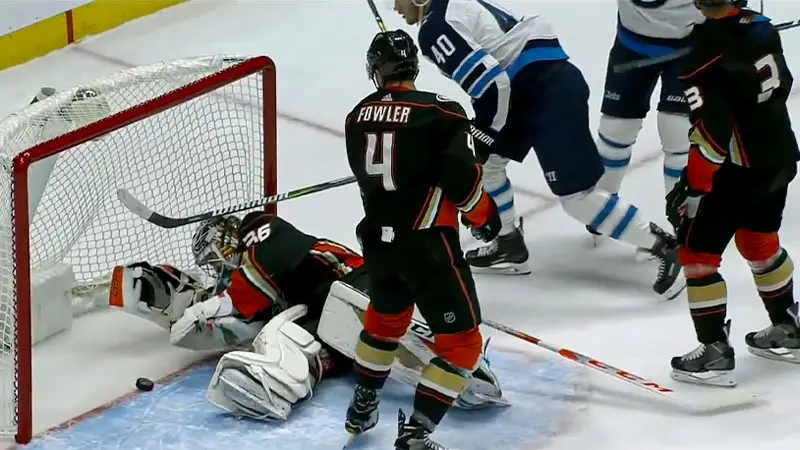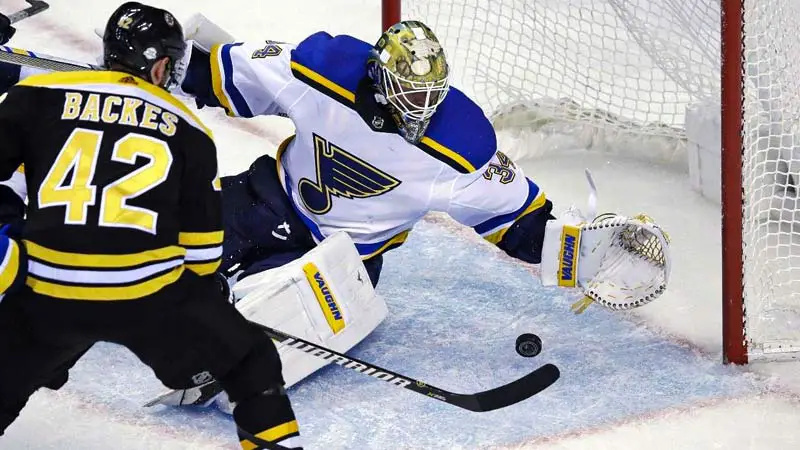Goalie interference in hockey is a pivotal aspect that can sway the outcome of games, sparking debates among fans, players, and officials. Understanding this rule is essential for appreciating the intricacies of the sport.
In this comprehensive guide, we delve into what is goalie interference in hockey, exploring the various forms it can take ranging from physical contact to strategic obstruction.
Discover how referees determine interference, the consequences it carries for teams, and the controversies that often surround these decisions.
From the impact on game momentum to the complexities of video review, this exploration aims to demystify the nuances of goalie interference.
It will also provide insights into a rule that adds both drama and controversy to the world of hockey. So, stay sharp.
What Is Goalie Interference In Hockey?
Goalie interference in hockey occurs when an offensive player interferes with the goaltender’s ability to make a save or move freely within the goal crease.
This interference can prevent the goalie from effectively doing their job and protecting the net.
Common examples include obstructing the goalie’s line of sight, making physical contact that hinders their movement, or impeding their ability to play the puck.
The primary objective is to maintain a fair and level playing field, ensuring that goaltenders have the opportunity to make saves without undue interference from opposing players.
When goalie interference is deemed to have occurred, the referee may disallow a goal scored by the offending team and, in some cases, penalize the player responsible.
Determining goalie interference can be subjective, leading to video reviews in some situations to make more accurate decisions.
Official Rules and Regulations Regarding Goalie Interference In Hockey
In hockey, goalie interference is a critical aspect governed by official rules and regulations to maintain fair play and uphold the integrity of the game.
The rules regarding goalie interference are outlined to ensure that goaltenders can effectively perform their role in protecting the net.
Here are some points regarding the official rules and regulations regarding goalie interference:
Definition of Goalie Interference
Goalie interference is officially defined as any physical contact or actions by an offensive player that impedes the goaltender’s ability to make a save or move freely within the goal crease.
This interference can take various forms, such as obstructing the goalie’s line of sight or restricting their movement.
Determining Interference
Referees are tasked with assessing whether goalie interference has occurred during a play.
This determination involves considering factors like the position of the offensive player in relation to the goaltender, the extent of physical contact, and whether the interference directly impacted the goalie’s ability to make a save.
Video Review
In some cases, particularly when the situation is contentious or not immediately clear, video review may be employed to make more accurate decisions regarding goalie interference.
Video footage allows officials to scrutinize the play from multiple angles and make informed judgments on whether interference occurred.
Consequences of Goalie Interference
When goalie interference is confirmed, the consequences can be significant. The most common outcome is the disallowance of a goal scored by the offending team.
Additionally, the player responsible for the interference may face penalties, such as time in the penalty box, depending on the severity of the infraction.
Coaches’ Challenge
In some hockey leagues, coaches have the option to challenge a goal based on the grounds of goalie interference.
If the challenge is successful, the goal is disallowed, and if unsuccessful, the challenging team may incur additional penalties.
This system provides teams with a mechanism to contest referee decisions and maintain the integrity of the game.
These rules and regulations surrounding goalie interference underscore the commitment of hockey organizations to ensure a fair and competitive environment for all teams and players.
Types of Goalie Interference in Hockey

In hockey, goalie interference manifests in various forms, each presenting unique challenges for officials to assess and penalize appropriately.
Understanding the types of goalie interference is crucial for players, coaches, and fans alike.
Here are some points detailing different types of goalie interference in hockey:
Physical Contact within the Crease
Goalie interference often involves physical contact between an offensive player and the goaltender, especially within the goal crease.
If an opposing player enters the crease and makes significant contact with the goalie, impeding their ability to move or make a save, it is considered interference.
This includes actions such as bumping, pushing, or deliberately obstructing the goalie’s movements.
Screening and Line of Sight Obstruction
Another common type of interference occurs when offensive players strategically position themselves in front of the net to obstruct the goaltender’s line of sight.
This tactic, known as screening, aims to obscure the goalie’s view of the puck and make it more challenging for them to track shots.
If this screening impedes the goalie’s ability to make a save, it may be deemed interference.
Puck Dislodgment
Goalie interference can occur when an offensive player’s actions lead to the dislodgment of the puck from the goalie’s possession.
For example, if a player intentionally knocks the puck out of the goalie’s glove or disrupts their control of the puck, resulting in a missed save opportunity, it constitutes interference.
Crease Violation
Entering the goal crease is allowed, but certain actions within this area can lead to interference penalties.
If an offensive player initiates contact with the goaltender while both are in the crease, and this contact affects the goalie’s ability to defend the net, it may be considered interference.
The crease violation aspect focuses on maintaining a fair playing field around the goal area.
Incidental Contact vs. Intentional Interference
Distinguishing between incidental contact and intentional interference is crucial in assessing goalie interference.
Incidental contact occurs when players unintentionally collide with the goaltender during play.
However, intentional interference involves deliberate actions by offensive players to disrupt the goalie’s performance, such as purposeful collisions or interference tactics.
Recognizing and penalizing these different types of goalie interference contributes to the overall fairness and competitiveness of hockey games.
Impact of Goalie Interference on Game Outcomes

Goalie interference plays a significant role in determining the outcomes of hockey games, as it directly influences scoring opportunities and the overall dynamics of play.
Understanding the impact of goalie interference on game outcomes is essential for teams, players, and fans alike.
Here are some points illustrating how goalie interference can shape the results of hockey matches:
Nullification of Goals
One immediate impact of goalie interference is the nullification of goals scored by the offending team.
If a player’s actions interfere with the goaltender’s ability to make a save, resulting in a goal, the officials may disallow the goal after a review.
This decision directly alters the scoreline, affecting the overall outcome of the game.
Shift in Momentum
Goalie interference incidents can lead to a shift in momentum within a game.
When a team’s goal is disallowed due to interference, it often serves as a turning point, influencing the psychological and emotional aspects of the game.
The offending team may lose momentum, while the defending team gains confidence and energy.
Penalties and Power Plays
Goalie interference often results in penalties against the offending player or team. These penalties can lead to power plays for the opposing team, creating numerical advantages on the ice.
The impact of these power plays on the game’s outcome is significant, as teams with more players on the ice have increased scoring opportunities.
Strategic Adjustments
Coaches and players may make strategic adjustments in response to goalie interference scenarios.
Teams may focus on defensive strategies to protect their goaltender, altering their gameplay to minimize the risk of interference penalties.
Conversely, the offending team may need to adjust its offensive approach to avoid penalties and maintain a competitive edge.
Emotional Impact and Game Control
Goalie interference incidents often evoke strong emotional responses from players, coaches, and fans. The emotional climate of a game can impact how teams control the flow of play.
Managing emotions effectively becomes crucial for teams to maintain composure and control, preventing the influence of goalie interference incidents from spiraling into a broader negative impact on the game’s outcome.
Controversies Surrounding Goalie Interference

Goalie interference in hockey often sparks controversies, with subjective interpretations and high-stakes game situations contributing to heated debates.
Understanding the controversies surrounding goalie interference sheds light on the challenges faced by officials and the impact on the game. Here are some elaborated points outlining the key controversies:
Subjectivity in Refereeing Decisions
One major source of controversy stems from the subjective nature of referee decisions on goalie interference.
Determining whether interference occurred can be challenging, as it involves assessing factors like intent, timing, and the impact on the goaltender.
Differing interpretations by officials and inconsistent application of the rules contribute to contentious situations.
Impact on Goal Review Systems
The introduction of goal review systems, including video replay, aimed to provide more accurate assessments of goalie interference.
However, controversies arise when even video reviews fail to provide clear-cut answers.
Challenges related to camera angles, the timing of incidents, and the interpretation of contact make it difficult to achieve consensus, leaving room for disagreements and disputes.
Game-Deciding Moments
Controversial goalie interference calls often occur during critical moments of a game, potentially deciding the outcome.
When a pivotal goal is disallowed or allowed due to interference, it can significantly impact the final score and influence playoff races.
The high stakes amplify the controversies, with teams, players, and fans intensely scrutinizing these game-deciding calls.
Inconsistencies in Enforcement
The application of goalie interference rules can vary from game to game and even within the same game.
Inconsistencies in enforcement contribute to controversies, as players and teams may feel that similar incidents are judged differently.
Addressing these inconsistencies is crucial for maintaining the integrity of the game and ensuring that rules are applied consistently across all teams.
Referee Accountability and Communication
Controversies often arise when there is a perceived lack of accountability or communication regarding referee decisions on goalie interference.
Fans, players, and coaches may call for increased transparency in the decision-making process.
Clear communication from referees about the rationale behind their decisions can help alleviate controversies and enhance understanding.
FAQs
What is goalie interference in hockey?
Goalie interference occurs when an offensive player obstructs the goaltender’s ability to make a save or move freely within the goal crease.
This interference can include physical contact, obstructing the goalie’s line of sight, or impeding their ability to play the puck.
How is goalie interference determined?
Referees assess factors like the nature of contact, the position of players, and the impact on the goaltender’s ability to make a save. Video review may be used to ensure accurate decisions in contentious situations.
What are the consequences of goalie interference?
If goalie interference is confirmed, the offending team’s goal may be disallowed.
Additionally, the player responsible may face penalties, impacting the game. The severity of consequences depends on the nature of the interference.
Can coaches challenge goalie interference calls?
Yes, in some hockey leagues, coaches have the option to challenge goalie interference calls.
A successful challenge results in the disallowance of the goal, while an unsuccessful challenge may lead to penalties for the challenging team.
What distinguishes incidental contact from intentional interference?
Incidental contact is unintentional collisions during play, while intentional interference involves deliberate actions to disrupt the goaltender.
Officials consider the nature of the contract and its impact on the goalie’s ability to make a save when making this distinction.
Wrapping Up
Goalie interference stands as a critical element in the tapestry of hockey, influencing goals, momentum, and the overall dynamics of play.
As we navigate through the subjective nature of referee decisions, the role of technology in reviews, and it becomes clear that goalie interference is more than just a rule—it’s a narrative thread woven into the excitement and unpredictability of the game.
Teams must adapt their strategies, fans must endure the emotional rollercoaster, and officials must grapple with the challenges of maintaining fairness.
As the puck drops and the goaltender guards the net, the specter of goalie interference adds layers to the sport, making each game a compelling saga of skill, strategy, and the ever-present element of uncertainty. Thank you.








James Felix